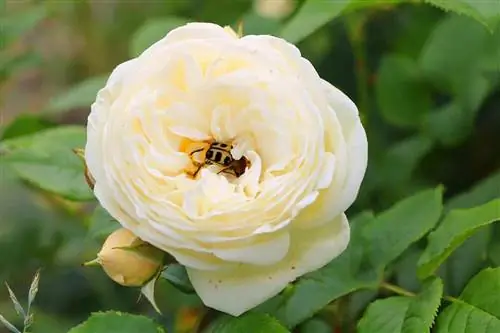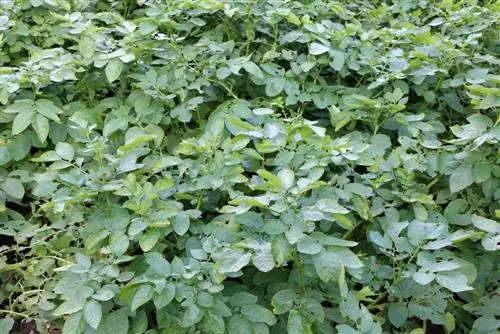- Author admin [email protected].
- Public 2023-12-17 03:39.
- Last modified 2025-01-24 12:45.
The most common cause of illnesses in real laurel is care errors. It is often the temperatures that are not optimal for the he althy growth of the tree. Incorrect watering behavior is more often to blame. So if your laurel gets brown leaves, you should first look at the roots to see if they are very dry or too wet. If neither is the case, look for pests that are usually located on the underside of the leaves or in the leaf axils. In most cases the cause is already apparent.
Drought damage
Although well-established laurel trees can tolerate occasional drought, you shouldn't overdo it. During the growth phase and also on hot summer days, the tree must be supplied with sufficient amounts of water. If this is not the case, the plant protects itself by first excluding the shoots furthest from the root from the water supply in order to save the remaining part.
Drought damage is often the cause of brown leaves on spiced laurel not only in summer, but especially in winter. Contrary to expectations, when parts of the plant turn brown, it often has nothing to do with the cold, but rather with a lack of water. Since the ground can freeze at temperatures below zero degrees, the laurel is unable to absorb moisture. This does not require severe frosts; even long periods just below freezing are enough to make a water supply impossible.
In addition, some hobby gardeners forget to water their plants sufficiently in winter. However, since the real laurel retains its foliage all year round, it is possible that in cold temperatures and sunshine there will be a large temperature difference between the (frozen) ball and the foliage warmed up by the sun.
- Be sure to put the plant in its winter quarters from the first frosts
- alternatively, place it in a slightly shaded place (protect from midday sun)
- leave brown leaves and shoots on the tree initially
- prune back in spring
- Consistently check the bale for moisture (summer and winter)
If the upper layer of the substrate has already dried, watering must be carried out again: penetrating in summer, restrained in winter. Make sure that excess water can drain away easily and remove the water from the saucer after watering to avoid waterlogging.
Waterlogging
If the spice laurel is placed in a tall planter from which the water cannot drain, the soil is too heavy overall or it is simply watered too often and too much, waterlogging can occur. A condition that the Mediterranean plant does not tolerate well. Although the substrate should always be slightly moist, especially during the growth phase, overall the plant is better kept a little drier than too moist.
If the leaves turn brown in winter, this is usually a sign that the amount of water is too high. In winter quarters (around 5 degrees) the laurel tree does not need a particularly high level of moisture. Watering once a week is usually enough.
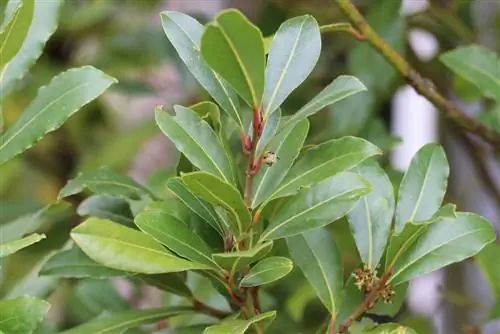
If the real laurel gets brown leaves and dies, the substrate should first be checked for moisture. If it is very dry, it needs to be watered more often. If it is very wet and already smells slightly putrid, you need to act quickly.
- Get the root ball out of the pot
- remove as much substrate as possible
- cut out all dead and rotten roots
- down to he althy tissue
- let it dry on newspaper for a few hours
- insert into fresh substrate
When repotting, make sure that you immediately fill in a thick layer of drainage material so that the laurel tree does not become too wet again in the future. The substrate should have a very high sand content; citrus plant soil, substrates for Mediterranean plants, high-quality potted plant soil or a mixture of 30% sand, clay and some humus green plant soil are best.
Tip:
It is preferable to use clay containers and place the plant pot either on small pot feet or alternatively on stones so that the water can drain away better.
Frost Damage
Many potted plants suffer in winter. The laurel tree is no exception. Since the plant is not sufficiently frost hardy, it should move to its cool and bright winter quarters from the first frosts, which usually occur around November. The optimal temperatures for wintering are 5 to 10 degrees. However, if you move your laurel too late or even leave it outside over the winter, you have to expect frost or drought damage to the plant. The brown, dry leaves clearly show that the tree has suffered.
- Examine the plant thoroughly
- If only the leaves are brown, a slight pruning is enough
- dry shoots must also be cut off
- cut back to the juicy wood
- If all the branches (and the trunk) are brown and dry inside, the plant can no longer be saved
- repot after pruning
- Substrate: good potting soil or humus-rich citrus plant soil
- the soil should be well permeable to water and slightly humus
Water the cut back and repotted laurel tree carefully and never put it outside in the cold. Preferably look for a very bright and cool but frost-free place for it. It can easily be overwintered in a bright basement or garage. If you have no way of overwintering your plant in a cool place, it can also be placed in the coolest room in the house. However, at temperatures above 10 degrees, a plant light should ensure sufficient lighting conditions.
Overfertilization
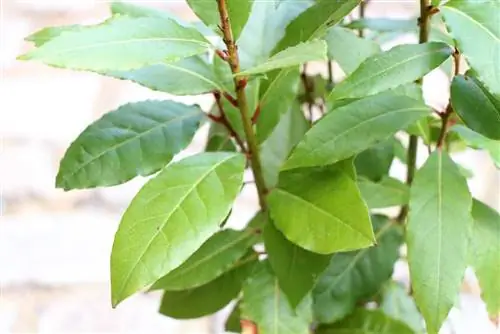
Since the real laurel reacts very sensitively to high s alt concentrations in the soil, it should preferably be fertilized with organic long-term fertilizer. Blue grain, large amounts of liquid fertilizer and the like lead to the death of the leaves and shoots in a very short time. If this is the case, the shrub can still be saved as long as you act quickly.
- Take the plant out of the pot and remove as much substrate as possible
- first by hand
- flush out remaining soil with the garden hose nozzle
- let it dry for a few hours
- Transpose into fresh, high-quality substrate
- water lightly
- first put it in a little shader
If the ball is already heavily rooted and it is not possible to completely remove the soil, it can help to place the root ball in a bucket or tub with fresh (room temperature) water. The s alts are usually very soluble in water and can be washed out. Let the plant stand in the water for about five minutes, occasionally lifting the ball to ensure better mixing.
Then let the roots drain well. This procedure is repeated about three times in order to dissolve any remaining solid components of the excess fertilizer. The laurel can then be potted in fresh substrate.
Wrong cut
Brown leaf edges often appear a few days after a cut. The spice laurel reacts to injury to the leaves by drying out at the interfaces. In principle, this doesn't pose a threat to the he alth of the plant, it just doesn't look particularly nice. In order to repair the damage, you should not cut off these brown areas, as this will only result in the underlying tissue dying again.
- renewed cutting measures necessary
- do not cut through the leaves
- always cut just above the base of a leaf
- shorten all affected shoots in this way
Pests
In addition to the weather-related damage and care errors mentioned above, the laurel tree is also occasionally a victim of pests that occur primarily in warm winter quarters. These include:
Scale insects
Scale insects are parasites that feed on plant juices. To do this, they suck out the cells primarily from soft and young tissue. That alone weakens the real laurel significantly. On top of that, the animals also release toxins that cause leaf discoloration and tissue death. Scale insects have an oval or round, light to dark brown shield. They are found on fresh, unwoody stems and leaves.
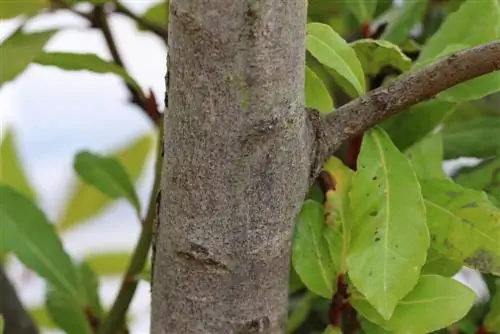
These are usually female animals that cling to the plant using a so-called suction spine. They raise their offspring (up to 2,000 young) under their shield, which consists of varnish and wax. The larvae cannot be seen with the naked eye, but they spread everywhere on the plant, suck its juices and excrete sugary feces, which then leads to the formation of sooty mold.
Symptoms:
- Growth disorders
- Tissue death
- brown leaves
- Formation of honeydew and sooty mildew
Combat
If the spice laurel is infested with scale insects, it must be urgently isolated from other plants, otherwise there is a risk that the animals will spread further. Combating plants that have already moved into their summer quarters outdoors is easier than with plants in their winter quarters.
- cut out diseased shoots
- Dab scale insects with a cotton swab soaked in alcohol
- loose stuck animals with a fine (tooth) brush
- Wash the entire plant with warm soft soap solution (1 liter of water plus 1 tablespoon of soft soap)
- then spray with a mixture of paraffin and rapeseed oil
- alternatively use neem oil
- Repeat procedure after 10 to 14 days (next generation)
- natural enemies: ladybirds and parasitic wasps
- watering with nettle manure
- spray fresh shoots with a mixture of paraffin and rapeseed oil
- Spray the potted plant with water and place it in a transparent plastic bag
- put in the shade for two weeks
Tip:
If you use pesticides to combat the pests, you will not be able to harvest leaves for consumption for the next few weeks and months.
Prevention
Since scale insects generally only attack weakened plants and also prefer certain living conditions, a few basic preventive measures are recommended.
- cool winter quarters (around 5 degrees)
- as much light as possible
- do not use nitrogen-based fertilizers
- spray occasionally when humidity is low
Mealybugs
Mealybugs are closely related to scale insects. Instead of the typical shields, these parasites protect themselves with wax that they produce in special glands. The animals themselves are usually difficult to recognize on the laurel tree. A fine, whitish web is characteristic of a mealybug infestation. These wax threads cover the animals and protect them from drying out and the sun. Unfortunately also against most pesticides. Some species lay eggs, others give birth to live offspring. Mealybugs excrete large amounts of honeydew and are therefore protected by ants against natural enemies in the wild. The citrus mealybug often occurs on potted plants. The lice suck on the leaves and at the same time excrete toxins.
Symptoms
- The infestation usually begins in the leaf axils
- A white, cotton-like web can be seen on shoots and leaves
- Leaves curl up and turn brown
- sticky honeydew drops form
- additional infestation with sooty mold (black deposits)
Combat
The first step in combating pests is always to prevent them from spreading further. So separate the diseased laurel from other plants.
- cut out affected and diseased plant parts generously
- Wash the entire plant with a soft soap solution (1 tablespoon of soft soap/liter of water)
- spray with paraffin oil
- then place in a transparent bag (shady) for 2 weeks
- make sure to keep it cooler in winter quarters
- alternatively: put potted plants outside when the weather is good
- natural enemies: ladybirds, lacewing larvae, parasitic wasps, hoverflies
Prevention
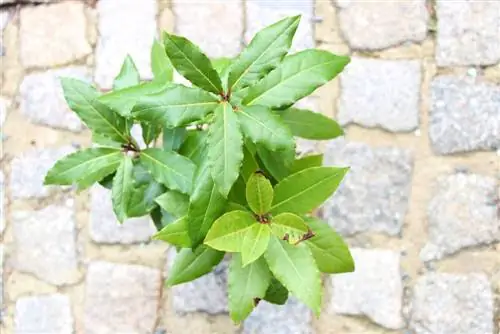
You can prevent pest infestation with an optimal location (summer and winter) and the right care. Strong, he althy laurel trees are very rarely attacked by pests.
- Sowing nasturtiums on the surface of the soil
- Spraying horsetail tea to strengthen the plant
- avoid nitrogen-rich fertilizers
- spray the young shoots with paraffin oil/white oil in winter and spring
You should also protect the laurel from ants all year round, as these literally cultivate mealybugs and protect them from natural enemies.
Conclusion
On the whole, the spice laurel is a fairly robust plant that rarely falls ill. The high concentration of essential oils in the leaves alone protects the tree well from most common pests. It is usually care errors that weaken the real laurel and cause it to die. In most cases, the plant can be saved through quick intervention and targeted countermeasures.


